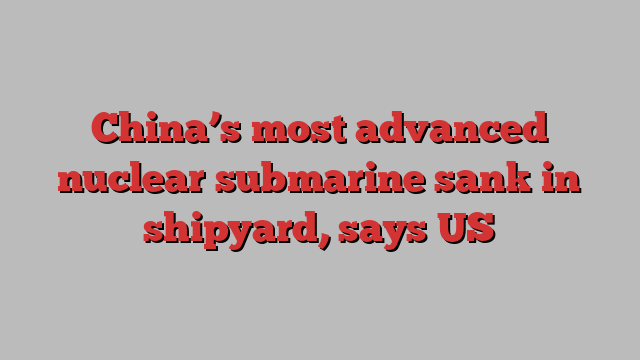
Unlock the Editor’s Digest for free
Roula Khalaf, Editor of the FT, selects her favourite stories in this weekly newsletter.
China’s most advanced nuclear attack submarine sank in May before going into service, the US said, setting back the People’s Liberation Army’s dash to catch up in one of Washington’s most pronounced military strengths.
The first vessel of the new Zhou class was seen in satellite pictures in May at a pier in the city of Wuhan as it was being prepared for its first sea trials.
But in early June, satellite images of the location on the Yangtze river only showed large floating cranes, which naval experts said would have been used to recover the vessel.
“It’s not surprising that the PLA Navy would try to conceal the fact that their new first-in-class nuclear-powered attack submarine sank pierside,” said a senior US defence official.
“In addition to the obvious questions about training standards and equipment quality, the incident raises deeper questions about the PLA’s internal accountability and oversight of China’s defence industry, which has long been plagued by corruption.”
China’s defence ministry did not respond to requests for comment. The Pentagon’s confirmation of the sinking was first reported by The Wall Street Journal.
While China now boasts the world’s largest naval force by number of ships and has a missile arsenal capable of putting US military assets across the Pacific at risk, a setback in its submarine programme could give the US military a badly needed reprieve in its race with Beijing for naval dominance in the Indo-Pacific.
The incident is also likely to be seen as the latest sign of strain on China’s military juggernaut. It follows Chinese President Xi Jinping’s purge of the entire leadership of the Rocket Force, in charge of conventional and nuclear missile operations.
The Chinese Communist party has presented the crackdown on the Rocket Force as part of an anti-corruption campaign centred on officials dealing with military procurement.
Observers said the damaged submarine was likely to be salvaged, cleaned and repaired by the shipyard that built it. When a US nuclear submarine sank pierside in 1969, its entry into service was delayed by more than two years.
“In this case, the delay could be even longer because this is a first-in-class boat,” said a western military official. “And then you have to look for the next anti-corruption campaign, if it starts in the PLA Navy now, too.”
Until a few years ago, the US Navy held an uncontested lead in undersea warfare, mainly due to its fleet of “super-quiet” nuclear-powered submarines.
In any conflict over Taiwan, that strength could allow US submarines to get close enough to target a Chinese invasion fleet and other PLA forces.
But over the past decade, naval analysts have observed rapid progress in Beijing’s efforts to master “super-quieting” nuclear propulsion technology.
Apart from the Zhou-class nuclear attack submarine, China is also working on a new nuclear-propulsion ballistic missile submarine. This month US deputy secretary of state Kurt Campbell said for the first time that Russia was helping China develop submarine technology.
China’s progress comes at a time when the US’s submarine strength is expected to be cut, as older vessels are retired and replacements are slow due to limited shipbuilding capacity.